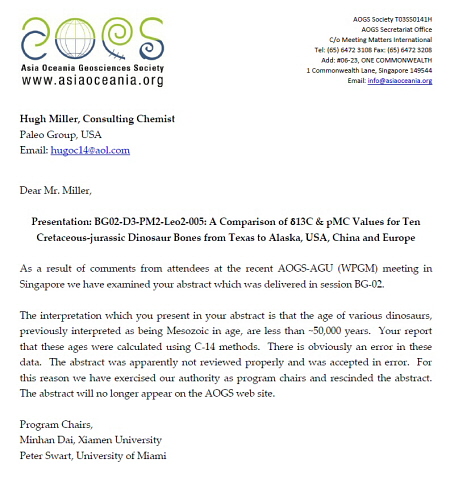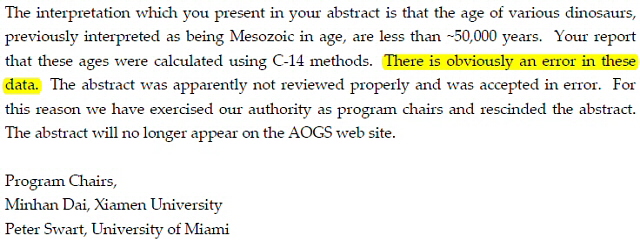You can date almost anything using proven scientific methods.
Yes indeed...
From...
https://www.newgeology.us/presentation48.html#:~:text=The theoretical limit for C-14 dating is 100,000,be one atom of C-14 left in them.
Carbon-14-dated dinosaur bones are less than 40,000 years old
s
Researchers have found a reason for the puzzling survival of soft tissue and DNA fragments in dinosaur bones - the bones are younger than anyone ever guessed. Carbon-14 (C-14) dating of multiple samples of bone from 8 dinosaurs found in Texas, Alaska, Colorado, and Montana revealed that they are only 22,000 to 39,000 years old.
Members of the Paleochronology group presented their findings at the 2012 Western Pacific Geophysics Meeting in Singapore, August 13-17, a conference of the American Geophysical Union (AGU) and the Asia Oceania Geosciences Society (AOGS).
Since dinosaurs are thought to be over 65 million years old, the news is stunning - and more than some could tolerate. After the AOGS-AGU conference in Singapore, the abstract was removed from the conference website by two chairmen because they could not accept the findings.Unwilling to challenge the data openly, they erased the report from public view without a word to the authors. When the authors inquired, they received this letter:
They did not look at the data and they never spoke with the researchers. They did not like the test results, so they censored them.
Carbon-14 is considered to be a highly reliable dating technique. It's accuracy has been verified by using C-14 to date artifacts whose age is known historically. The fluctuation of the amount of C-14 in the atmosphere over time adds a small uncertainty, but contamination by "modern carbon" such as decayed organic matter from soils poses a greater possibility for error.
Dr. Thomas Seiler, a physicist from Germany, gave the presentation in Singapore. He said that his team and the laboratories they employed took special care to avoid contamination. That included protecting the samples, avoiding cracked areas in the bones, and meticulous pre-cleaning of the samples with chemicals to remove possible contaminants. Knowing that small concentrations of collagen can attract contamination, they compared precision Accelerator Mass Spectrometry (AMS) tests of collagen and bioapatite (hard carbonate bone mineral) with conventional counting methods of large bone fragments from the same dinosaurs. "Comparing such different molecules as minerals and organics from the same bone region, we obtained concordant C-14 results which were well below the upper limits of C-14 dating. These, together with many other remarkable concordances between samples from different fossils, geographic regions and stratigraphic positions make random contamination as origin of the C-14 unlikely".
The theoretical limit for C-14 dating is 100,000 years using AMS, but for practical purposes it is 45,000 to 55,000 years, depending on the type of equipment. The half-life of C-14 is 5730 years. If dinosaur bones are 65 million years old, there should not be one atom of C-14 left in them.
Clearly something is wrong with the conventional wisdom about dinosaur bones, but it has been hard to reach the public with the information. Despite being simple test results without any interpretation, they were not allowed to be presented in conference proceedings by the 2009 North American Paleontological Convention, the American Geophysical Union in 2011 and 2012, the Geological Society of America in 2011 and 2012, and by the editors of various scientific journals. On one occasion, they were allowed to display a
poster. The information was finally published in an
online journal on January 3, 2020, presenting the Carbon-14 data from dinosaur bones alongside similar data from other material in the geologic column.
SetiAlpha6...
Isn’t this exactly what Scientists dream about?
Overturning long held false paradigms with fresh new ideas and scientific data?
You guys must be really excited!!!
You’re welcome!
But, no need to thank me!





